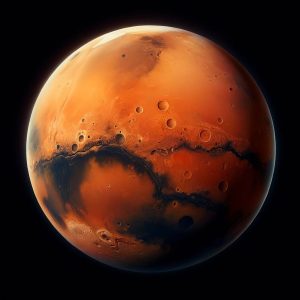1. Known as the Red Planet, Mars is characterized by its red, dusty landscape.
2. The atmosphere on Mars is very thin, composed mainly of carbon dioxide (95%), nitrogen (2.7%), and argon (1.6%), with traces of oxygen and water.
3. The orbital speed of Mars is 24.2 km per second (54,133 mi/hr).
4. Temperatures on Mars vary from 0°C (32°F) to -100°C (-148°F).
5. The diameter of the planet Mars is 6,785 km.
6. A Mars year is equal to 686.98 Earth Days.
7. A day in Mars is equal to 24.6 Earth Hours.
8. Mars maximum distance from the Sun = 249 million km (155 million miles).
9. Mars is 35 million miles from Earth.
10. Mars is the god of war in Roman mythology (Ares).
11. Mars has two small satellites named Phobos and Deimos.
12. Asaph Hall discovered both of Mars’ moons, Phobos and Deimos, in August 1877.
13. Mariner 4 – first successful flyby mission to Mars. Launched on November 28, 1964 and arrived at Mars on July 14, 1965.
14. Mariner 9 – first successful orbit of Mars. Launched May 30, 1971 and began orbit November 13, 1971.
15. Viking 1 – Successful orbit and landing on surface of Mars. Launched August 20, 1975 and arrived at Mars July 20, 1976.
16. If you weigh 100 lbs, your weight on Mars would be 38 lbs. (multiply your actual weight by 0.38).
17. Phobos, one of Mars' two moons, is gradually getting closer and closer to Mars. It is believed that it will eventually collide with the planet.
18. The surface of Mars is covered in canyons and valleys. This leads scientists to believe that the planet once had water on it.
19. Just like Earth, both of Mars' poles are blanketed in ice.
20. Of all the volcanoes in the Solar System, Mars has the tallest. It is named Olympus Mons and it stands at 15 miles high, or three times that of Mount Everest.

